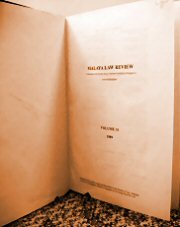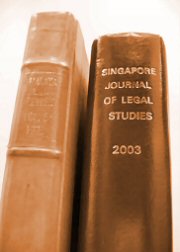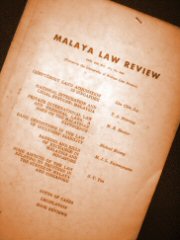| 421. | DECEMBER 2009 Issue | p.646 |
|
|
| Case & Legislation Comment: Private Purpose Trusts and the Rule Against Perpetuities
Barry C. Crown • [2009] Sing JLS 646 (Dec)
|
| 422. | DECEMBER 2009 Issue | p.661 |
|
|
| Review Essay: Negotiating the Antinomies of the Singapore Constitutional Order: A Review Essay of Evolution of a Revolution: Forty Years of the Singapore Constitution by Li-ann Thio and Kevin Tan, eds.
Davinia Abdul Aziz • [2009] Sing JLS 661 (Dec)
|
| 423. | DECEMBER 2009 Issue | p.671 |
|
|
| Book Review: Encounters with Singapore Legal History: Essays in Memory of Geoffrey Wilson Bartholomew by KevinY.L. Tan and Michael Hor, eds.
Ian Holloway • [2009] Sing JLS 671 (Dec)
|
| 424. | DECEMBER 2009 Issue | p.674 |
|
|
| Book Review: Secured Transactions Reform and Access to Credit by Frederique Dahan and John Simpson, eds.
Dora S. Neo • [2009] Sing JLS 674 (Dec)
|
| 425. | DECEMBER 2009 Issue | p.677 |
|
|
| Book Review: Exploring Contract Law by Jason W. Neyers, Richard Bronaugh and Stephen G.A. Pitel, eds.
Goh Yihan • [2009] Sing JLS 677 (Dec)
|
| 426. | JULY 2009 Issue | p.1 |
|
|
| The Journey of a Journal: 50 Years of the Singapore Journal of Legal Studies
Kevin Y.L. Tan • [2009] Sing JLS 1 (Jul)Beginning life in 1959 as the University of Malaya Law Review, the journal has undergone several transformations over the past half century, becoming first the Malaya Law Review and then the Singapore Journal of Legal Studies. In addition,it has also spawned two other journals - the Singapore Journal of International and Comparative Law (now the Singapore Yearbook of International Law) and the Asian Journal of Comparative Law. This essay takes a historical look at the development of the journal and the key personalities who have made it one of Asia's most respected legal publications.
[Full Text]
|
| 427. | JULY 2009 Issue | p.25 |
|
|
| Public Interest in Sentencing: Deterrence or Desert or Anything Else?
Tan Yock Lin • [2009] Sing JLS 25 (Jul)The notion of public interest in sentencing conjures up images of utilitarian consequentialism and the emergence in Singapore of a role for public interests analysis in sentencing may create a superficial impression of judicial hardening and the beginnings of a new and repressive law and order ideology. This article demonstrates that the impression is not only superficial but also false. Its central argument is that public interests analysis is or has the potential to contribute clarity and add value to desert-based sentencing and that taken together with judicial benchmarking, which it complements, reflects a model of desert, which is neither deontological nor empirical. Nevertheless, the resultant model is not necessarily inferior to either.
|
| 428. | JULY 2009 Issue | p.52 |
|
|
| Courting Religion: The Judge between Caesar and God in Asian Courts
Thio Li-ann • [2009] Sing JLS 52 (Jul)Religion is almost universally guaranteed as a fundamental liberty and human right, although the scope of religious freedom and understandings of religious identity within secular democracies are informed by the specific model of constitutional secularism practiced. States often evidence an ambivalent attitude towards religion, treating it as Law's Other, that is, a competing normative system which has regulative force on social behaviour and influences conceptions of citizenship and affective loyalties. This article examines the interpretive method of two secular Asian courts, which are meant to be bastions of impartiality, in negotiating questions of religious identity and religious freedom. It analyses the judicial weighting and balancing of relevant competing factors and considers the varied understanding of what secularity requires and whether the concerns of religious minorities are adequately safeguarded within secular polities where religion remains an important social force.
[Full Text]
|
| 429. | JULY 2009 Issue | p.80 |
|
|
| The Paradox of Securities Markets Efficiency: Where to Next?
Razeen Sappideen • [2009] Sing JLS 80 (Jul)This article examines the claim of securities markets efficiency based on the efficient markets hypothesis (EMH), which Fama proclaimed to be a well substantiated truth in 1978. Behavioural theory shows that individuals do not act to maximise their utility as asserted by neoclassical economists, while entrepreneurial theory explains share price movements to be the product of error prone guesswork by market participants. Alongside this, the emergence of the shareholder value concept in the late 1980s advocated by both corporate managers and outsider market makers has undermined the very foundations of share price efficiency. This undermining seems to have been caused by forces exogenous to the firm. Nonetheless, securities markets are highly competitive. This article explains the need for a new theory to explain the inherent paradox.
|
| 430. | JULY 2009 Issue | p.109 |
|
|
| The Efficacy of Securities Investors' Rights in Singapore
Alexander F.H. Loke • [2009] Sing JLS 109 (Jul)Despite a steady trickle of enforcement actions taken against market misconduct by the Singapore regulators, no securities class actions have arisen out of these enforcement actions, which have ranged from misleading statements and market manipulation to the failure to comply with on-going disclosure obligations. This article examines whether the paucity of securities class actions might be attributable to the nature of the rights that securities investors possess. In doing so, the analysis reveals answers to an important theoretical question - the extent to which current rights protect the securitiesinvestor's interest in the fair and accurate pricing of securities.
|
|







